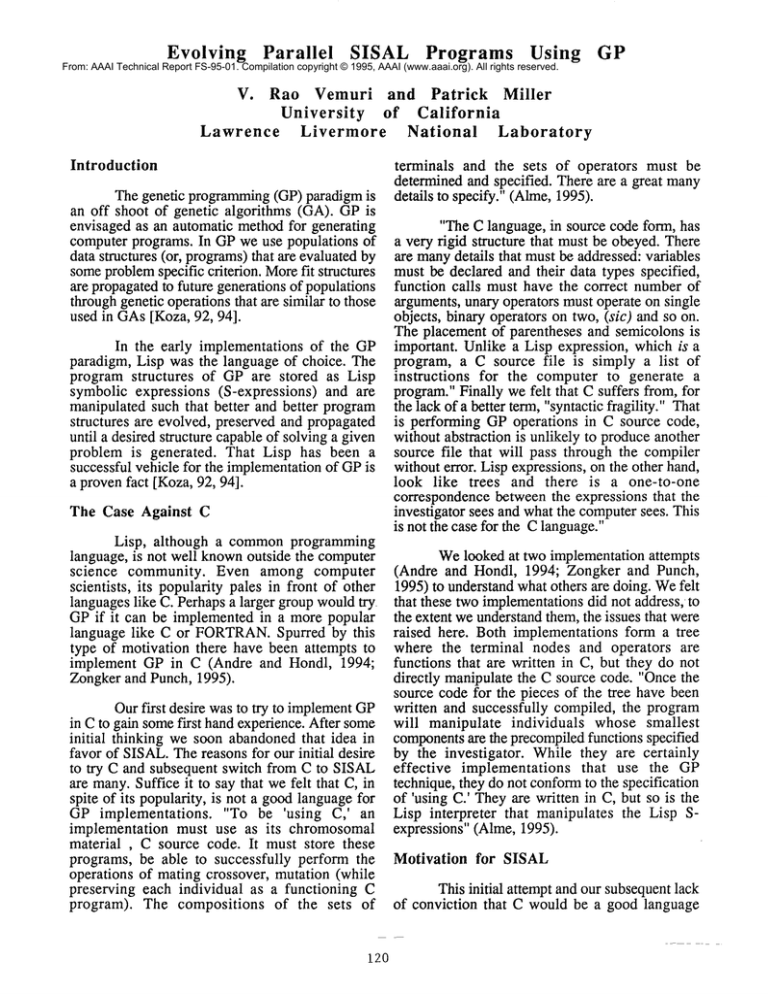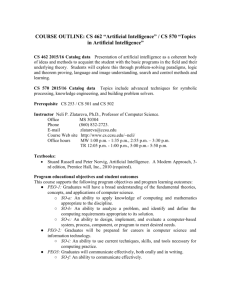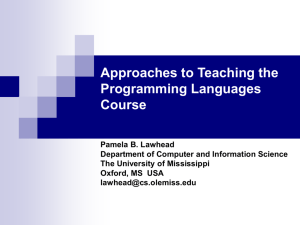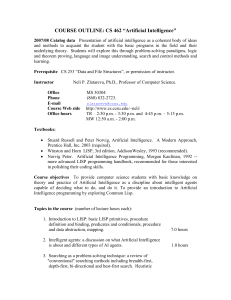
Evolving
Parallel
SISAL Programs
Using
GP
From: AAAI Technical Report FS-95-01. Compilation copyright © 1995, AAAI (www.aaai.org). All rights reserved.
V.
Rao Vemuri and Patrick
University
of California
Lawrence
Livermore
National
Introduction
The genetic programming(GP) paradigm
an off shoot of genetic algorithms (GA). GP
envisaged as an automatic method for generating
computer programs. In GP we use populations of
data structures (or, programs)that are evaluated
someproblemspecific criterion. Morefit structures
are propagatedto future generations of populations
through genetic operations that are similar to those
used in GAs[Koza, 92, 94].
In the early implementations of the GP
paradigm, Lisp was the language of choice. The
program structures of GP are stored as Lisp
symbolic expressions (S-expressions) and are
manipulated such that better and better program
structures are evolved, preserved and propagated
until a desired structure capable of solving a given
problem is generated. That Lisp has been a
successful vehicle for the implementationof GPis
a proven fact [Koza, 92, 94].
The Case Against C
Lisp, although a commonprogramming
language, is not well knownoutside the computer
science community. Even among computer
scientists, its popularity pales in front of other
languages like C. Perhaps a larger group wouldtry
GP if it can be implemented in a more popular
language like C or FORTRAN.
Spurred by this
type of motivation there have been attempts to
implement GP in C (Andre and Hondl, 1994;
Zongker and Punch, 1995).
Miller
Laboratory
terminals and the sets of operators must be
determined and specified. There are a great many
details to specify." (Alme,1995).
"The C language, in source code form, has
a very rigid structure that must be obeyed. There
are manydetails that must be addressed: variables
must be declared and their data types specified,
function calls must have the correct numberof
arguments, unary operators must operate on single
objects, binary operators on two, (sic) and so on.
The placement of parentheses and semicolons is
important. Unlike a Lisp expression, which is a
program, a C source file is simply a list of
instructions for the computer to generate a
program." Finally we felt that C suffers from, for
the lack of a better term, "syntactic fragility." That
is performing GP operations in C source code,
without abstraction is unlikely to produce another
source file that will pass through the compiler
without error. Lisp expressions, on the other hand,
look like trees and there is a one-to-one
correspondence between the expressions that the
investigator sees and what the computersees. This
is not the case for the C language."
Welooked at two implementation attempts
(Andre and Hondl, 1994; Zongker and Punch,
1995) to understandwhat others are doing. Wefelt
that these two implementationsdid not address, to
the extent we understandthem, the issues that were
raised here. Both implementations form a tree
where the terminal nodes and operators are
functions that are written in C, but they do not
directly manipulate the C source code. "Oncethe
source code for the pieces of the tree have been
Ourfirst desire was to try to implementGP written and successfully compiled, the program
in C to gain somefirst hand experience. After some will manipulate individuals whose smallest
initial thinking we soon abandonedthat idea in componentsare the precompiledfunctions specified
favor of SISAL.Thereasons for our initial desire by the investigator. While they are certainly
to try C and subsequent switch from C to SISAL effective
implementations that use the GP
are many.Suffice it to say that wefelt that C, in technique, they do not conformto the specification
spite of its popularity, is not a goodlanguagefor of ’using C.’ Theyare written in C, but so is the
GP implementations.
"To be ’using C,’ an Lisp interpreter that manipulates the Lisp Simplementation must use as its chromosomal expressions" (Alme, 1995).
material , C source code. It must store these
programs, be able to successfully perform the Motivation for SISAL
operations of mating crossover, mutation (while
preserving each individual as a functioning C
This initial attempt and our subsequentlack
program). The compositions of the sets of of conviction that C would be a good language
120
prodded us to look at other alternatives. One
immediate candidate happened to be SISAL, a
language developedby a team that included a group
from Lawrence Livermore National Laboratory.
The motivations for the selection of SISALare
different fromthose behindthe initial trials with C.
SISALdefinitely is not a language that is in
widespread usage; it is still an experimental
language. The first version was designed in 1983.
At the time of this writing SISALhas beeninstalled
at well over 70 sites internationally.
alternation).
GP generated programs in the
intermediate form can also be "uncompiled" into
SISAL source. We feel that the SISAL/ IF1
combinationwill be easier to manipulatethan C and
will yield higher-performance, parallel programs
that are not obtainableusing Lisp.
Acknowledgment:
The authors were benefited by discussions with
Tom DeBoni of Lawrence Livermore National
Laboratory. They thank Prof. John Koza for
inspiring us to undertakethis work.
That we abandoned our effort with C and
embarked on an exploration of SISAL is no
absolute verdict against C or any other language. References
Granted that SISALis lot moreobscure than Lisp.
Our desire to experiment with SISALis motivated Alme, H. J. (1995) ComputerizedDarwinism:
because it is a parallel language. Althoughit can
Applying genetic programmingto C source
run in a uniprocessor environment, its speed
code, Termpaper submitted in partial
advantage is fully realized whenused on parallel
fulfillment of the requirements of AEL216G
architectures. Finally, we wanted to learn the
taught by Prof. V. Vemuriin Winter 1995.
fallacies and pitfalls of evolvingparallel programs
and for this objective SISALis as good as any Andre, D. and Hondl, C. (1994) Dave’s Genetic
other parallel language.
ProgrammingCode in C, Informal Report,
Stanford University, April 28, 1994.
SISAL(Streams and Iterations in a Single
AssignmentLanguage)is a functional language that Cann, D. C. "Retire FORTRAN:
A Debate
Rekindled", CACM,August 1992
takes advantageof parallel architectures (McGraw,
et al. 1985). It is a proven high performance,
parallel language system (Cann, 1992). The Feo, J. T. Miller, P. J. and Skedzielewski,S. K.
SISAL90 language (Feo, et. al. 1995) has added
(1995) "SISAL90", Proc. High Performance
higher order objects makingthe language capable
Parallel Computing’95, Denver, Colorado.
of defining and manipulating run-time structures.
April 1995.
SISALdefines and uses pure functions that map
input data to results. These wouldform the basis Koza, J. R. (1992) Genetic Programming:On the
Programming of Computers by Means of
for functional chromosomesmuch as with LISP.
Recursive
composition
of functions
is
Natural Selection, MITPress, 1992.
straightforward. SISALhas important capabilities
Koza, J. R. (1994) Genetic Programming II:
that may be important in GP. These include
iterative constructs that maybe moreeffective than
Automatic Discovery of Reusable Programs,
recursion,
automatic parallelization
and
MITPress, 1994.
vectorization, a static typing system that makes
compilation more effective, and the tree based McGraw,J. Skedzielewski, S., Allan, S.
intermediate form IF1 (Skedzielewski, et. al,
Oldehoeft, R., Glauert, J., Kirkham,C.,
Noyce, B. and Thomas, T. (1985) SISAL:
1985).
Streamsand Iterations in a Single Assignment
Unlike GPstrategies in C where only small
Language: Reference ManualVersion 1.2.
atomic functions maybe easily manipulated at the
Manual M-146, Rev. 1, Lawrence Livermore
source level, SISALmaybe manipulated using its
National Laboratory, Livermore, CA, March
hierarchical intermediate. This IF1 sub languageis
1985.
conceptually identical to S-expressions in lisp.
Variable declarations are unnecessarybecause they Skedzielewski, S. and Glauert, J. (1985) IF1 are implicit in its structure. Programscan be built
intermediate formfor applicative languages,
up from the language’s atomic operations and user
Version 1.0, ManualM-170, Lawrence
functions (the genes) into complex chromosomal
LivermoreNational Laboratory, Livermore,
structures within the intermediate’s hierarchical
CA, July 1985.
operations (iteration, parallel do-across, and
121






